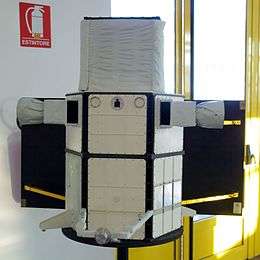AGILE (satellite)
 A model of the satellite. | |
| Mission type | Gamma-ray astronomy |
|---|---|
| Operator | ASI |
| COSPAR ID | 2007-013A |
| SATCAT № | 31135 |
| Website |
agile |
| Mission duration | 8 years |
| Spacecraft properties | |
| Manufacturer | Compagnia generale per lo spazio, ex Carlo Gavazzi Space |
| Launch mass | 352 kilograms (776 lb) |
| Start of mission | |
| Launch date | 23 April 2007, 10:00:00 UTC |
| Rocket | PSLV C8 |
| Launch site | Satish Dhawan SLP |
| Contractor | ISRO |
| Orbital parameters | |
| Reference system | Geocentric |
| Regime | Low Earth |
| Semi-major axis | 6,892.13 kilometres (4,282.57 mi) |
| Eccentricity | 0.0017574 |
| Perigee | 509 kilometres (316 mi) |
| Apogee | 533 kilometres (331 mi) |
| Inclination | 2.47 degrees |
| Period | 94.90 minutes |
| Epoch | 4 December 2013, 04:13:37 UTC[1] |
AGILE (Astro‐Rivelatore Gamma a Immagini Leggero) is an X-ray and Gamma ray astronomical satellite of the Italian Space Agency (ASI).
Objectives
AGILE's mission is to observe gamma-ray sources in the universe. Key scientific objectives of the AGILE Mission include the study of:[2]
- Active Galactic Nuclei
- Gamma-Ray Bursts
- X-ray and gamma galactic sources
- Non-identified gamma sources
- Diffuse galactic gamma emissions
- Diffuse extra-galactic gamma emissions
- Fundamental physics
Instrumentation
AGILE's instrumentation includes a Gamma Ray Imaging Detector (GRID) sensitive in the 30 MeV - 50 GeV energy range, a SuperAGILE (SA) hard X-ray monitor sensitive in the 18–60 keV energy range, a Mini-Calorimeter (MCAL) non-imaging gamma-ray scintillation detector sensitive in the 350 keV - 100 MeV energy range,[3] and an Anti-coincidence System (AC), based on a plastic scintillator, to assist with suppressing unwanted background events.
The SuperAGILE SA is an instrument based on a set of four silicon strip detectors, each equipped with one-dimensional coded mask. The SA is designed to detect X-Ray signals from known sources and burst-like signals. It provides long-term monitoring of flux and spectral features. MCAL can also effectively detect high-energy radiation bursts in its energy band.
Launch and operations
AGILE was successfully launched on 23 April 2007, from the Indian base of Sriharikota and was inserted in an equatorial orbit with low particle background. On 23 April 2007, ASI made contact with AGILE; its signals were acquired by the ground station at the Broglio Space Centre near Malindi, Kenya and it was placed in a Sun-pointing mode.[4]
Results
Some transient events detected by AGILE are associated with positions not consistent with a known source (Gamma Ray Burst) and have cosmological origins. Others are due to solar flares, while some are due to Earth atmosphere events (Terrestrial Gamma Flash).
References
| Wikimedia Commons has media related to AGILE (satellite). |
- ↑ Peat, Chris (4 December 2013). "AGILE - Orbit". Heavens Above. Retrieved 6 December 2013.
- ↑ ASI AGILE
- ↑ Scientific Goals and Instrument Performance of the Gamma-Ray Imaging Detector AGILE
- ↑ "It will be Israeli satellite in August". Chennai, India: The Hindu. 25 April 2007.
External links
- "AGILE – Gamma Ray Light Detector – Astrorivelatore Gamma ad Immagini LEggero". Carlo Gavazzi Space.
- "AGILE Launch Campaign (DEAD URL)". iasf-bo.
- "AGILE - Status and recent detections". INAF-IAPS.
| ||||||||||||||||||||||||||||||||||||||
| ||||||||||